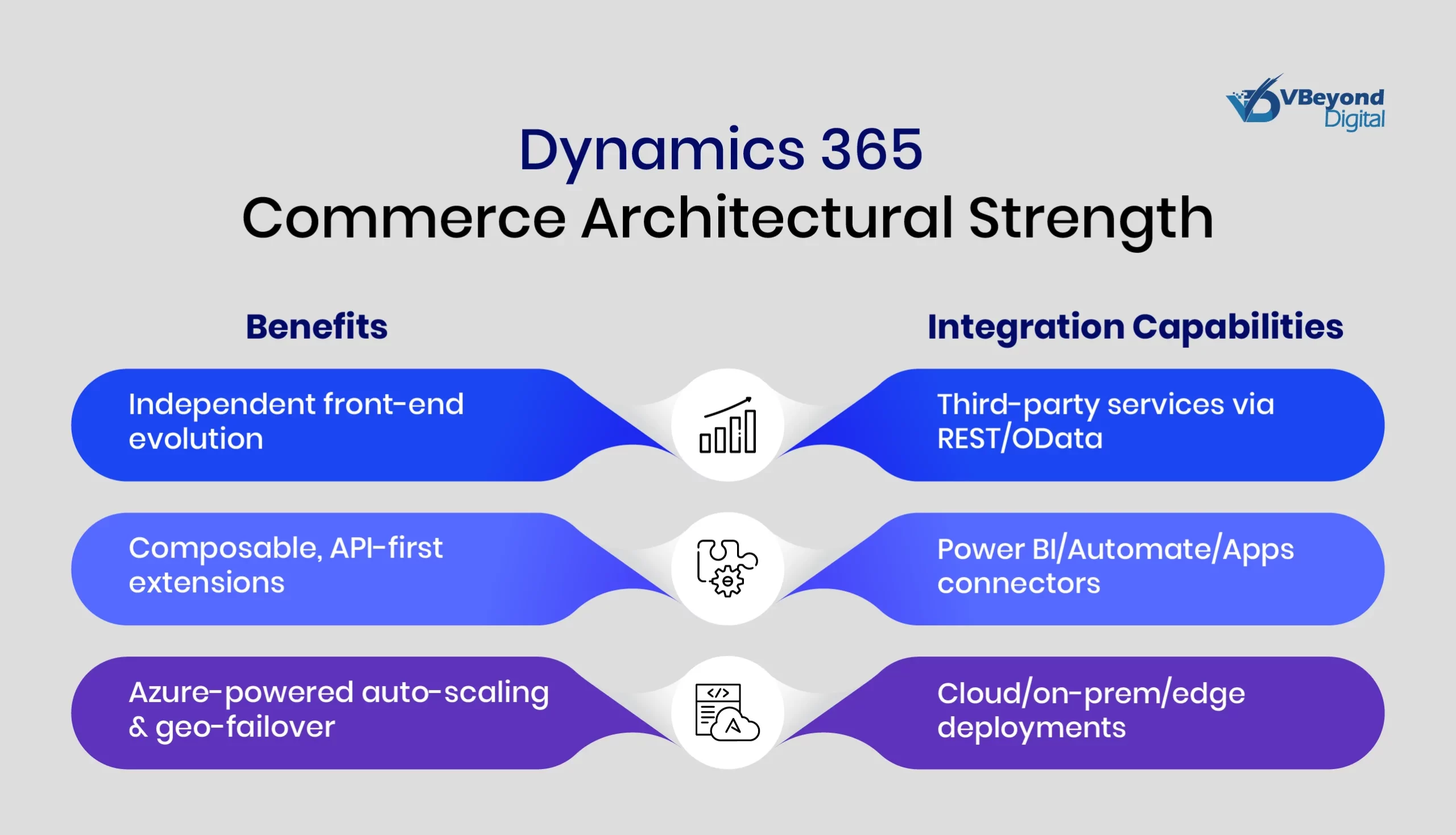How Dynamics 365 Commerce Drives Scalable, Multi-Channel E-Commerce Operations
Section
- Modern payments support: Asynchronous notifications via the out-of-the-box Adyen connector, enabling Pay by Link QR-code payments and buy-now-pay-later options like Klarna, Affirm, and Afterpay. Merchants also receive real-time alerts on disputes, capture failures, and reconciliation reports.
- Multifaceted pricing strategies: A unified pricing module supports attribute-based pricing, segment-specific rules, long-term trade agreements, short-term adjustments, promotional discounts, auto-charges, and retrospective rebates—ensuring price consistency and rapid response to market shifts.
- Stronger offline resilience: IT managers gain device-health dashboards, data compression for offline databases, and proactive notifications to maintain store operations during network outages.
Enterprises seeking to build or grow their multi-channel e commerce operations often encounter three core hurdles: fragmented systems that hinder order fulfillment velocity, inconsistent customer journeys across touchpoints, and escalating demands for rapid, personalized service.
These pain points not only inflate operational overhead but also erode customer loyalty when experiences fall short of expectations. As an omnichannel e commerce platform, Dynamics 365 Commerce consolidates disparate data flows and operational processes into a single unified commerce platform, giving technology leaders the visibility and control needed to react swiftly to shifting market conditions.
Challenges Modern Retail Enterprises Face
- Operational Silos and System Fragmentation. Many retailers juggle online storefronts, point-of-sale applications, and mobile apps that each use proprietary APIs and distinct data schemas, leading to manual reconciliations, delayed order processing, and reporting gaps.
- Inconsistent Customer Experiences Across Touchpoints. Shoppers expect identical product availability, pricing, and loyalty rewards whether they engage online, in-store, or via mobile—but integration lags and data conflicts often result in mismatched offers, out-of-stock errors, and abandoned carts.
- Rising Expectations and Market Agility Demands. Modern consumers demand same-day delivery, click-and-collect options, and real-time personalization; without rapid adaptability, enterprises risk eroding market share to more nimble competitors.
The Solution
- Centralized Operations Through a Unified Commerce Platform: Dynamics 365 Commerce brings e-commerce, in-store, and call center operations into one multi-channel e commerce platform, ending silos and manual integrations while ensuring consistent data across every channel.
- Seamless Integration with the Wider Dynamics 365 Suite: By embedding within the Dynamics 365 ecosystem, the solution shares real-time customer, inventory, and financial data with Finance, Supply Chain, and Customer Service modules—so your teams gain actionable insights without building custom middleware.
- Scalable, API-First Architecture: An API-driven, headless commerce engine enables independent front-end updates, third-party service integration, and support for cloud, edge, or hybrid deployments, giving IT leaders the flexibility to expand into new markets and channels with minimal risk.
Make the move to Dynamics 365 Commerce
How Does Dynamics 365 Commerce Work?
Unified Commerce Platform
Dynamics 365 Commerce unites e-commerce, in-store, and call-center operations within a single unified commerce platform, replacing disconnected systems that exacerbate e-commerce challenges.
This omnichannel e commerce platform supports real-time inventory and order processing across every touchpoint, delivering visibility into stock levels and order statuses to reduce discrepancies and improve fulfillment velocity.
Centralized product and customer data streams through the multi-channel integration layer, enabling consistent pricing, promotions, and loyalty rewards across digital storefronts and physical terminals.
By consolidating back-office, call center, and online channels, IT directors gain a holistic view of customer journeys, which drives smarter stocking decisions and more personalized service models.
Advanced Payment Processing
The 2025 Release Wave 1 introduces asynchronous payment processing connectors for platforms like Adyen, enabling Pay by Link checkout via QR codes and direct links within the multi-channel e commerce platform.
Native integration with buy-now-pay-later providers such as Klarna, Affirm, and Afterpay extends payment choices, which has been shown to reduce cart abandonment and increase average order value.
Shoppers benefit from real-time status updates on payment authorizations, captures, and dispute resolutions, which feed directly into Dynamics 365 Commerce dashboards for proactive issue management.
These capabilities not only enhance customer trust but also simplify reconciliation workflows, reducing manual effort and error rates in financial operations.
Centralized Pricing Management
Dynamics 365 Commerce features a unified pricing module that supports attribute-driven rules, incorporating customer segments, product lines, and order volume parameters to meet complex business requirements.
Sales order attributes can be applied to trigger promotional pricing, volume discounts, or contract-based rate cards within the omnichannel retail solution.
Central management of pricing strategies ensures consistency across online, in-store, and call-center interactions, which mitigates disputes and compliance risks.
Price changes propagate instantly across all channels via the unified commerce platform, enabling IT teams to respond to market fluctuations and pricing pressures with minimal latency.
Enhanced Offline Capabilities
For scenarios with intermittent connectivity, Dynamics 365 Commerce offers robust offline database management through async and sync libraries that cache master data locally on POS terminals.
IT directors can configure proactive health checks and alerts that monitor store systems, triggering maintenance workflows before service disruptions occur.
Offline operations also include delta-based data synchronization, which compresses and transfers only changed records to reduce bandwidth usage and accelerate reconnection.
Maintaining uninterrupted checkout and fulfillment during network outages secures business continuity and preserves revenue streams in distributed retail environments.

Architectural Strength: Headless Commerce Engine
At its core, Dynamics 365 Commerce employs a headless commerce engine—known as the Commerce Scale Unit—that serves as the central integration point for all commerce business logic across your multi-channel e commerce platform. This API-first architecture decouples front-end experiences (web, mobile, in-store kiosks) from back-end logic, enabling independent updates that improve your time-to-market for new features and reduce risk when responding to e commerce challenges.
Design Overview
The Commerce Scale Unit hosts the headless commerce engine and exposes OData APIs built on ASP .NET Core, allowing Dynamics 365 Commerce and third-party applications to consume business logic uniformly. Authentication options (OAuth, Azure AD) ensure secure access to commerce APIs, while a componentized design lets your teams extend or override services—supporting true multi-channel integration without creating custom middleware.
Benefits
- Independent Front-End Evolution. By separating UI components from core services, development teams can iterate on storefronts, POS interfaces, or custom kiosks without impacting transaction processing or inventory rules.
- Friction-Free Composable Commerce. Building on a unified commerce platform, you can gradually adopt API-based services—such as specialized personalization engines or loyalty modules—while retaining a consistent data model across channels.
- Accelerated Scalability. Hosted on Microsoft Azure’s resilient infrastructure (including Azure Cosmos DB and Azure Entra identity services), the Commerce Scale Unit benefits from global distribution, auto-scaling, and geo-failover, supporting rapid growth and high transaction volumes without degradation.
Integration Capabilities
The headless commerce engine provides a single integration surface for:
- Third-Party Services. Connect to payment gateways, AI recommendation engines, and marketing platforms via standardized REST/OData endpoints—simplifying extensions and reducing integration costs.
- Microsoft Power Platform. Leverage Power BI, Power Automate, and Power Apps connectors to build custom dashboards, workflows, and mobile apps that operate on live commerce data.
- Hybrid and Edge Deployments. Deploy Commerce Scale Units on cloud, on-premises hardware, or edge nodes to optimize performance in high-latency or regulated environments, ensuring business continuity even during network outages.
Sustained Omnichannel Excellence with Dynamics 365 Commerce
Establishing Governance Framework
Dynamics 365 Commerce brings together customer data from online storefronts, in-store purchases, and call-center interactions into a single unified customer profile, enabling a full 360-degree view of buyer behavior and preferences.
It integrates natively with Dynamics 365 Customer Insights to enrich these profiles with behavioral and transactional data, driving more precise segmentation and personalized engagement strategies.
Real-Time Inventory Tracking
Dynamics 365 Commerce leverages the Inventory Visibility microservice in Dynamics 365 Supply Chain Management to provide real-time on-hand inventory information across every sales channel.
This real-time inventory tracking minimizes overselling and backorders by allowing systems to reserve, adjust, and replenish stock based on live data—improving order fulfillment efficiency and customer satisfaction.
Personalized Shopping Experiences
Built-in AI and machine-learning models in Dynamics 365 Commerce generate product recommendations that reflect the unique purchase trends of individual customers and similar buyer segments, increasing average order value and engagement.
By applying AI-driven insights, your omnichannel e-commerce platform can tailor promotions, content, and search results to each shopper’s profile and context, boosting conversion rates and loyalty.
Operational Efficiency
The D365 Commerce Operational Insights dashboard aggregates metrics from POS, online, and back-office systems, delivering actionable analytics on sales performance, inventory health, and service KPIs.
Automation features—such as AI-managed product assortment updates and automated inventory restocking workflows—reduce repetitive tasks and free staff to focus on strategic activities.
Moreover, integration with Dynamics 365 Supply Chain Management enables automated order fulfillment orchestration, optimizing warehouse assignments and shipping routes to cut costs and accelerate delivery times.
Scalability and Global Reach
Built on Microsoft Azure
Dynamics 365 Commerce runs Azure’s global network of data centers, leveraging auto-scaling, geo-replication, and high-availability features. Azure Cosmos DB’s multi-master replication ensures consistent, low-latency data access worldwide, and Azure Entra provides enterprise-grade identity and access management across the region. Enterprises can choose cloud, on-premises, or edge deployments of the Commerce Scale Unit to align with performance needs and compliance mandates in any geography.
Global Compliance Features
To address fiscal and regulatory obligations, Dynamics 365 Commerce offers a comprehensive compliance framework. The Universal Tax Rate API enables seamless integration with providers like Avalara and Vertex, automating accurate tax determination, return filing, and certificate management across over 12,000 jurisdictions. Built-in system compliance settings manage data residency and privacy laws (GDPR, CCPA) through audit trials and role-based permissions, ensuring your omnichannel e commerce solution adheres to global standards.
Support for Multiple Currencies and Languages
Dynamics 365 Commerce supports multi-currency pricing and native-language storefronts. Catalogs can be priced in local currencies with real-time exchange-rate updates managed by the finance modules, reducing conversion errors and streamlining checkout for international customers. The integrated CMS offers localization features—such as content releases and multi-item publishing—so marketing teams can roll out regional promotions and translated content packages efficiently.
Adaptability to Regional Requirements
Preconfigured tax and duty models, combined with attribute-driven pricing rules, allow administrators to scope promotions, shipping, and pricing strategies by country or region. This ensures compliance with local tax, trade, and labor regulations without custom development. Coupled with Dynamics 365 Supply Chain Management, the platform automates cross-dock, drop-ship, and warehouse allocations based on regional performance metrics, scaling fulfillment operations while minimizing manual oversight.
Conclusion: Strategic Advantages for Technology Leaders
By replacing multiple point solutions with one unified commerce platform, organizations can reduce total cost of ownership and simplify maintenance across e-commerce, in-store, and call-center channels. Its API-driven headless architecture decouples front-end deployments from core services, accelerating time-to-market for new features and reducing integration risk. Deploying Microsoft Azure scalability—including autoscaling compute and geo-replication—ensures high availability and consistent performance under peak loads, supporting global expansion without infrastructure bottlenecks.
Ready to optimize your Azure commerce platform? Connect with our experts now.
FAQs (Frequently Asked Question)
Dynamics 365 Commerce is a unified platform that brings together online storefronts, in-store point-of-sale, and call-center operations into a single solution for real-time inventory and order management across multiple channels. It delivers consistent customer experiences and centralized data to improve fulfillment speed and visibility.
Dynamics 365 Commerce integrates with Finance, Supply Chain Management, and Customer Service modules within the Dynamics 365 suite to share real-time customer, inventory, and financial data without custom middleware. Integration occurs via secure OData APIs exposed by the Commerce Scale Unit, enabling seamless data flows across the broader ecosystem.
The platform supports asynchronous payment notifications and connectors for providers such as Adyen, Klarna, Affirm, and Afterpay, enabling Pay by Link, QR-code checkouts, and buy-now-pay-later options. Real-time alerts for captures, disputes, and reconciliation feed directly into Commerce dashboards, simplifying financial workflows.
Dynamics 365 Commerce includes a unified pricing engine that supports attribute-based pricing, volume discounts, promotional rules, and retrospective rebates via Retail Server pricing APIs such as GetActivePrices and CalculateSalesDocument. External applications can consume pricing data and apply or remove coupons programmatically using these APIs.
Dynamics 365 Commerce’s Store Commerce app supports offline mode by automatically switching to an offline database when the Commerce Scale Unit is unavailable. Offline data synchronization is managed by Commerce Data Exchange, ensuring that master data and transactions are replicated and reconciled as connectivity is restored.
At its core, Dynamics 365 Commerce employs a headless commerce engine, the Commerce Scale Unit, which decouples front-end experiences from back-end logic via secure OData APIs. This API-first design allows independent updates to storefronts, mobile apps, and kiosks without impacting transaction processing.
Developers can extend the Commerce storefront and back office using the Dynamics 365 Commerce online SDK, which supports Node.js environments and Webpack bundling for custom modules, themes, and integrations. The SDK’s extensibility points allow packaging e-commerce extensions that integrate seamlessly with the core platform.




